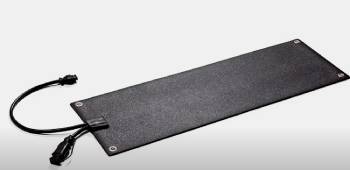Winter can be beautiful, but dealing with ice and snow on your walkways and steps? Not so much. If you’re tired of shoveling, slipping, or salting your way through the season, HeatTrak mats could be the solution you’ve been searching for.
These snow-melting mats promise to keep your paths clear without all the backbreaking labor. I’ve tested them myself, read countless reviews, and compared them with other brands to see if they live up to the hype. Spoiler alert: If safety, convenience, and reliability matter to you, HeatTrak mats are worth every penny. Let’s break it all down.
What Are HeatTrak Mats?

HeatTrak mats are electric, snow-melting mats designed to keep your walkways, stairs, and entrances clear of snow and ice without the hassle of shoveling or salting. Made from a durable, corrosion-resistant material, these mats are built to withstand harsh winter conditions and can be left outside all season long.
They work by gently heating up to melt snow at a rate of about two inches per hour, ensuring that your pathways remain safe and slip-free even during a storm.
One of the best things about HeatTrak mats is their ease of use. Instead of dealing with bags of ice melt or spending time clearing snow manually, you simply plug the mats into a power source, and they do all the work for you.
They come with a textured surface for added traction, reducing the risk of slips and falls. The system is modular, so you can connect multiple mats to cover larger areas, making them a great option for porches, sidewalks, stairs, and even small driveways.
Unlike permanent heated driveway systems that require professional installation and a hefty upfront investment, HeatTrak mats are portable and easy to set up, making them a practical alternative for homeowners who need a more flexible snow-melting solution.
They also use less energy than in-ground heating systems, keeping your electricity costs reasonable. Whether you want to prevent dangerous ice buildup or simply make winter maintenance easier, HeatTrak mats offer a reliable, low-maintenance way to keep your outdoor spaces safe and accessible.
My Experience with HeatTrak Mats
I was skeptical about HeatTrak mats at first, but after a brutal winter left my walkway covered in ice, I decided to give them a try. Setting them up was surprisingly easy—no complicated installation, just unroll them, plug them in, and let them do their job. Within 30 minutes, I noticed the snow melting away, leaving a clear, dry path. The textured surface also provided extra grip, which was a huge relief since I’ve had my fair share of close calls on icy stairs.
One of the biggest advantages was how much time and effort I saved. Normally, I’d be outside shoveling multiple times a day, especially after heavy snowfall. With the HeatTrak mats, I could simply turn them on, and they’d melt the snow before it had a chance to accumulate.
They even worked well in temperatures below freezing, keeping my front steps and walkway completely ice-free. I also appreciated that they didn’t require harsh chemicals or salt, which can damage concrete and be harmful to pets.
The only downside is that they aren’t exactly cheap, especially if you need multiple mats for a large area. However, considering the safety, convenience, and durability they offer, I see them as an investment.
I no longer have to worry about slipping or spending hours clearing snow, and that peace of mind is worth it. If you’re tired of winter maintenance and want a hassle-free solution, HeatTrak mats are definitely worth considering.
How to Get the Most Out of HeatTrak Mats?
Want the best performance from your HeatTrak mats? Here’s how to maximize their efficiency:
- Turn them on before snowfall – This ensures snow never accumulates in the first place.
- Keep them plugged in during storms – They use minimal energy and work best when continuously running.
- Remove excess snow if needed – If a storm dumps more than 2 inches per hour, you may need to clear some snow manually.
- Use them strategically – Place mats in high-traffic areas where ice buildup is most dangerous.
- Store them properly in the off-season – Roll them up and keep them in a dry place to prolong their lifespan.
Is HeatTrak Worth the Price?

If you live in an area with harsh winters, the answer is a resounding yes. While these snow-melting mats come with a higher price tag than traditional ice melt or a good old-fashioned shovel, they offer a level of convenience, safety, and durability that’s hard to beat.
Think about the time and effort you spend clearing your steps, walkway, or porch after every snowfall. With HeatTrak, you simply plug them in, and they do the work for you—no more shoveling, no more slipping, and no more back-breaking labor. The textured surface provides extra grip, making them even safer than bare pavement in wet conditions.
Energy efficiency is another major perk. HeatTrak mats use far less electricity than in-ground heated driveways, keeping your energy costs reasonable while still maintaining a clear walking surface.
Plus, they’re built to withstand brutal winters, meaning you won’t need to replace them every season. Many users report using their mats for years without any issues, making them a long-term investment rather than a recurring expense.
Yes, they’re more expensive upfront, and you do need to purchase a separate power unit, but when you consider the cost of medical bills from a slip-and-fall accident or the sheer hassle of constant snow removal, the price becomes much easier to justify.
If safety, convenience, and durability matter to you, HeatTrak is well worth the investment. It’s one of those winter upgrades you won’t regret once the snow starts falling.
Pros and Cons of HeatTrak Mats

Pros:
- Effective Snow and Ice Removal: HeatTrak mats melt snow at a rate of about 2 inches per hour, preventing ice buildup and keeping walkways clear.
- Easy to Use: Simply plug them in, and they start working—no shoveling, salting, or chemical treatments needed.
- Durable and Weather-Resistant: Made from industrial-grade materials, these mats withstand harsh winter conditions and can be left outside all season.
- Energy-Efficient: Compared to traditional heated driveway systems, HeatTrak mats use far less electricity, making them a cost-effective option.
- Safe for Concrete and Pets: Since they don’t require salt or chemicals, they help preserve your pavement and protect pets’ paws from irritation.
- Modular Design: They can be connected to cover various areas, from steps to full walkways, providing customizable coverage.
- Quick Melting Time: Within 30 minutes to an hour, you can see results, making them useful for sudden snowfalls.
- Minimal Maintenance: Once set up, they require little attention beyond occasional cleaning and storing them properly after winter.
Cons:
- High Initial Cost: These mats are more expensive than traditional snow removal methods, especially if you need multiple mats for a larger area.
- Requires an Outdoor Power Source: They need to be plugged in to function, which may require extension cords or additional outlets.
- Not Ideal for Heavy Snowfall: If snow accumulates too quickly before they’re turned on, you may need to remove excess snow manually before they can work effectively.
- Power Unit Sold Separately: You need a HeatTrak power unit to operate them, which is an additional purchase.
- Limited Heat Coverage: They warm up to 40°F above the ambient temperature, so in extreme cold, melting may take longer.
- Not Designed for Vehicles: While durable, they aren’t meant to withstand the weight of cars, making them unsuitable for driveways unless used in pedestrian areas only.
Also Read: My Thoughts On Crystal Clear Memories
HeatTrak Mats Vs. Other Brands
- HeatTrak Mats Vs. Thermo-Tex Heated Mats
HeatTrak mats and Thermo-Tex heated mats both offer snow-melting solutions, but they cater to slightly different needs. HeatTrak mats are designed for heavy-duty winter conditions, capable of melting snow at a rate of 2 inches per hour. They’re built from durable, weather-resistant material and can be left outside all season. Thermo-Tex mats, on the other hand, are typically thinner and better suited for lighter snowfall. They also tend to be more budget-friendly but may not be as effective in extreme winter conditions. If you need serious snow-melting power, HeatTrak is the stronger option, though it comes at a higher price point.
- HeatTrak Mats Vs. Summerstep Heated Mats
Summerstep heated mats provide a similar function to HeatTrak but with a slightly different approach. While both brands offer industrial-grade materials and weather resistance, HeatTrak mats generally have a higher melting rate and a more rugged design. Summerstep mats often emphasize energy efficiency, consuming slightly less power while still providing decent snow-melting performance. However, their heating capacity may be lower than HeatTrak’s, making them less effective in areas with heavy snowfall. If you prioritize energy savings over melting speed, Summerstep could be a viable alternative, but for maximum performance, HeatTrak still has the edge.
- HeatTrak Mats Vs. Heatizon Snow Melting Mats
Heatizon snow melting mats differ from HeatTrak in that they are designed to be embedded in driveways, walkways, and patios rather than laid on top. This makes Heatizon a more permanent solution, but installation can be complex and costly. HeatTrak mats, by contrast, require no installation—just plug them in, and they start working immediately. If you’re looking for a quick, hassle-free way to keep your walkways clear, HeatTrak is the better option. But if you’re undergoing major renovations and want a built-in system, Heatizon might be worth considering.
- HeatTrak Mats Vs. Powerblanket Snow Melting Mats
Powerblanket snow melting mats offer another alternative to HeatTrak, but they are primarily used for industrial applications. These mats are often larger and designed for high-power heating, sometimes even for use under vehicles or large outdoor areas. While HeatTrak is ideal for home use, Powerblanket mats are better suited for construction sites or commercial properties. If you need a reliable residential snow-melting solution, HeatTrak is more practical and cost-effective. However, for larger-scale operations, Powerblanket might be worth the investment.
- HeatTrak Mats Vs. CozyWinters Snow Melting Mats
CozyWinters offers heated mats similar to HeatTrak, with a focus on providing safe, non-slip surfaces. While both brands prioritize durability and effectiveness, CozyWinters mats tend to be slightly less powerful in terms of snow-melting speed. HeatTrak mats can handle heavier snowfall and colder temperatures, making them a better choice for harsh winter climates. However, CozyWinters mats might be preferable if you’re looking for something slightly more affordable with similar safety features. If budget is a major concern, CozyWinters could be an alternative, but for maximum reliability, HeatTrak is the superior option.
Also Read: My Thoughts On American Floor Mats
Frequently Asked Questions (FAQs)
Yes! HeatTrak mats effectively melt snow and prevent ice buildup. They work best when turned on before snowfall starts.
You can leave them on for extended periods, especially during ongoing snowfall. They’re designed for continuous use and won’t overheat.
No, these mats are not designed for vehicle traffic. They’re best for walkways, porches, and stairs.
HeatTrak mats are energy-efficient, consuming far less electricity than full driveway heating systems. Their exact power consumption depends on the mat size and duration of use.
Final Thoughts
If you’re tired of shoveling or worried about slipping on ice, HeatTrak mats are a fantastic investment. They’re easy to use, effective, and built to last. While they aren’t the cheapest option, they provide unmatched convenience and peace of mind. For anyone dealing with harsh winters, these mats are a game-changer.



